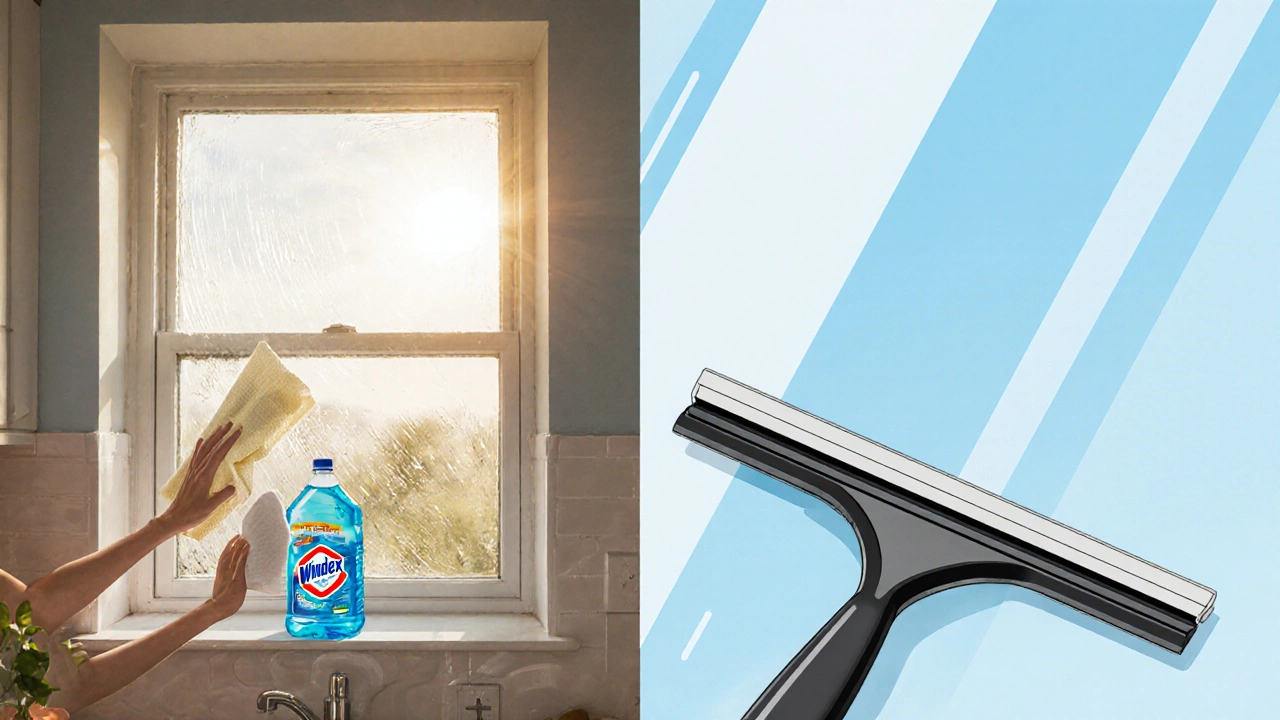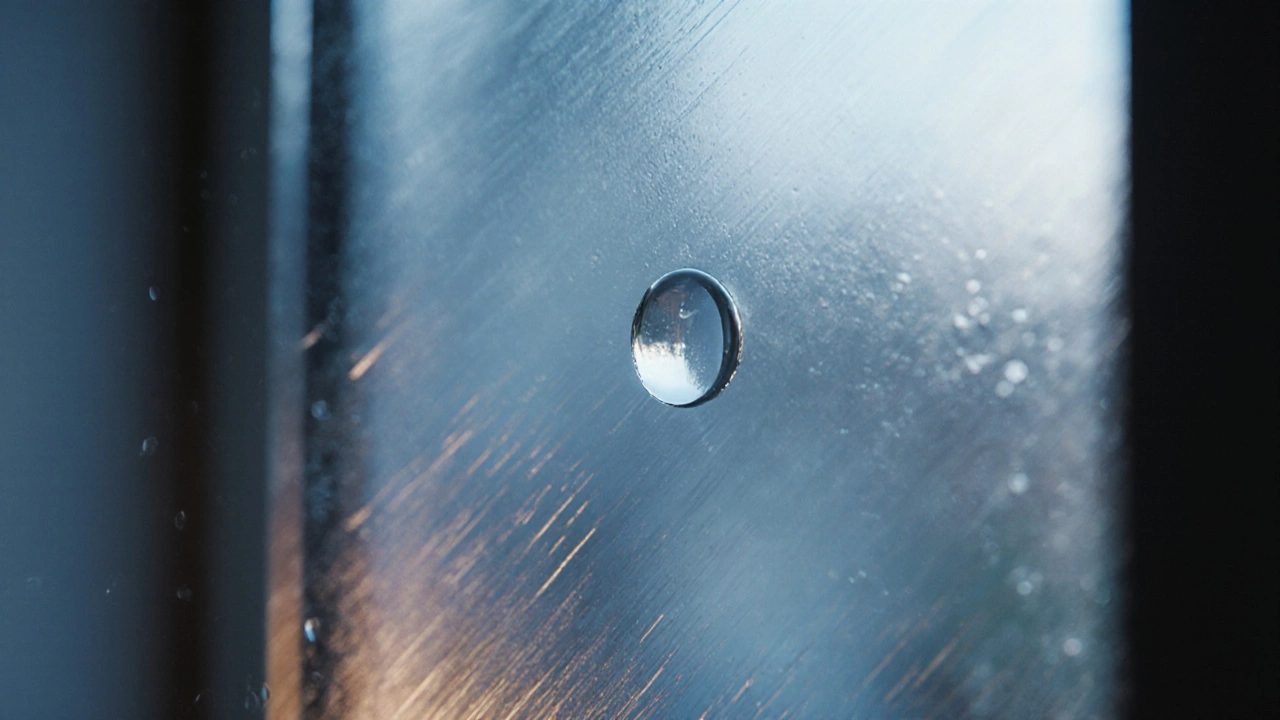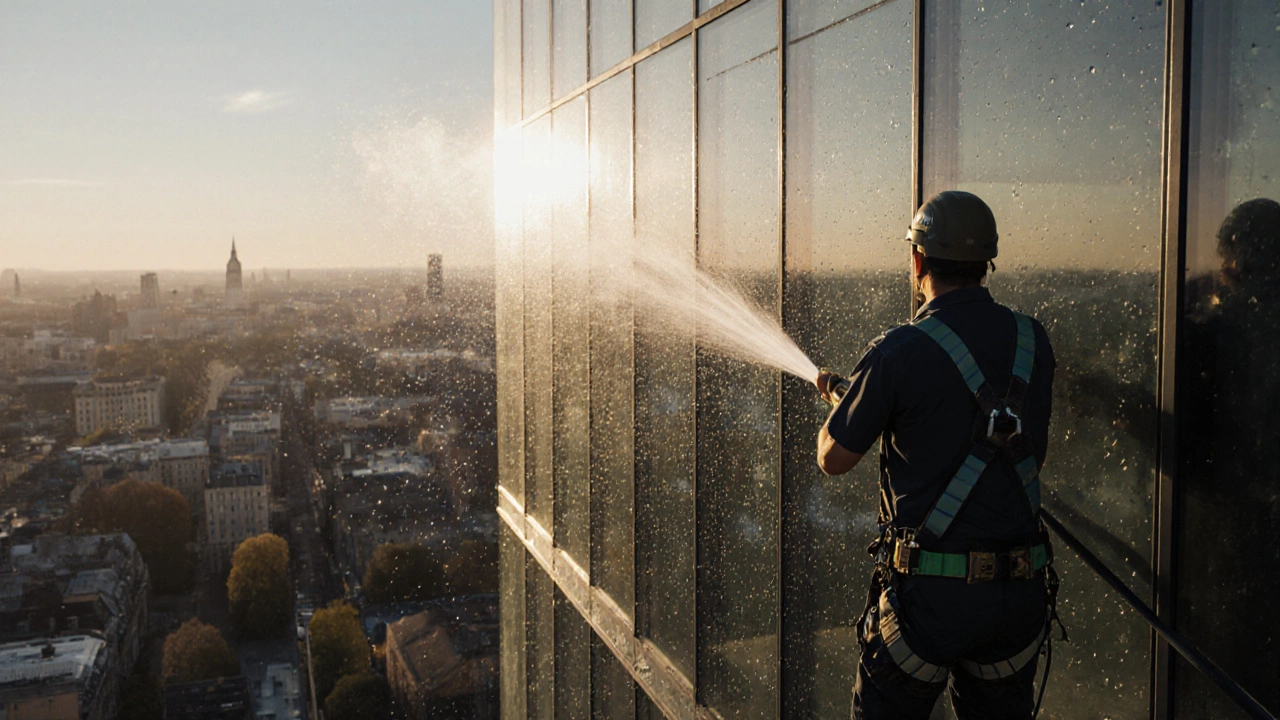Window Cleaning Method Comparison Tool
Key insight: Professional methods avoid ammonia-based cleaners that damage modern glass coatings and leave mineral residue.
Ever watched a window cleaner work and wondered why they never reach for that blue bottle labeled Windex? You’ve seen it in supermarkets, in your kitchen cabinet, maybe even used it yourself on the glass in your bathroom. It’s cheap, it’s everywhere, and it promises a sparkling finish. So why do professionals avoid it like it’s radioactive?
Windex Wasn’t Built for Big Windows
Windex was designed for small, indoor glass surfaces-mirrors, TV screens, kitchen windows. It’s a household product, not a professional tool. Window cleaners work on multi-story buildings, conservatories, skylights, and panoramic glass facades. They need solutions that work fast, dry quickly, and leave zero residue. Windex? It’s too thick. It leaves behind a faint oily film, especially under sunlight. That’s why your home windows might look clean right after you wipe them, but by afternoon, they’re streaky and smudged.
Professional window cleaners use ammonia-free solutions with high-purity water. Why? Because ammonia in Windex reacts with certain types of glass coatings, especially those on energy-efficient or tinted windows. Over time, repeated use can cause clouding, discoloration, or even permanent damage. That’s not a problem on your bathroom mirror, but it’s a $5,000 repair job on a custom-built conservatory.
The Water Matters More Than the Cleaner
Most people think cleaning is about the chemical. Professionals know it’s about the water. Tap water in Oxford, like most cities, contains minerals-calcium, magnesium, iron. When it dries on glass, those minerals stay behind as white spots. That’s why your windows look cloudy after you wash them with tap water and a sponge.
Professional cleaners use deionized or purified water. This water has had all minerals and impurities removed. It doesn’t leave behind any residue. When it dries, it just… vanishes. That’s why their windows look like they’ve been polished with a diamond. They don’t need strong chemicals. Pure water does the job.
Think of it like this: Windex is like using soap to wash your car. It might remove dirt, but it leaves soap scum. A professional car wash uses purified water and specialized rinses. Same principle.
Tools Are Part of the Formula
Window cleaners don’t just use water-they use tools designed for precision. Squeegees with rubber blades that are replaced weekly. Extendable poles with microfiber heads. Water-fed poles that deliver purified water directly to the glass from the ground. These tools work together to remove dirt without touching the surface, reducing smudges and scratches.
Windex, on the other hand, is usually applied with paper towels or cheap cloths. Those fibers shed. They leave lint. They trap dirt and smear it across the glass. A professional squeegee removes water in one clean motion. No wiping. No rubbing. No lint. No streaks.
Time and Efficiency Are Everything
Imagine you’re cleaning 50 windows on a commercial building. You’ve got a two-hour window before the sun hits the east side and starts causing streaks. Windex takes longer to dry. It requires multiple passes. You have to wipe it off, then go back and polish. That’s two minutes per window. Fifty windows? That’s over an hour and a half just drying and wiping.
With a water-fed pole and purified water, a pro can clean the same 50 windows in under 40 minutes. The water dries in seconds. No wiping needed. No chemicals. No residue. No second pass. That’s efficiency. That’s profit.

Windex Is a Chemical Risk
Windex contains ammonia, isopropyl alcohol, and surfactants. These are fine for occasional use on a kitchen window. But professionals handle cleaning solutions all day, every day. Repeated exposure to ammonia can irritate the eyes, skin, and lungs. It’s not a big deal if you use it once a week. But if you’re spraying it 200 times a day, five days a week? That’s a health hazard.
Professional cleaners use non-toxic, biodegradable formulas. They’re safer for the user, safer for pets, safer for plants below the windows. They’re also better for the environment. Windex bottles end up in landfills. Many professional solutions come in refillable containers and are packaged with sustainability in mind.
Streaks Are the Enemy-Here’s How They’re Avoided
Streaks aren’t caused by dirt. They’re caused by uneven drying. Windex evaporates slowly. As it dries, the dirt and chemicals concentrate at the edges, leaving trails. Professional systems prevent this by using water that evaporates uniformly and tools that remove all moisture in one pass.
Here’s the trick: the best window cleaners work in the shade. Or early morning. Or late afternoon. They avoid direct sunlight because heat makes any solution dry too fast-and fast drying means streaks. Windex users often clean in daylight, not realizing they’re fighting the sun. Pros plan their day around it.
What Happens When You Use Windex on Professional Glass?
Some people think, “It’s just glass. What’s the harm?” But modern windows aren’t just plain glass. Many have low-emissivity (Low-E) coatings, solar control films, or anti-reflective layers. These are delicate. Ammonia-based cleaners like Windex can break down those coatings over time. The result? Windows lose their energy efficiency. They become harder to clean. They start to look foggy or discolored.
One client in Oxford had a 12-foot glass wall in their living room. They cleaned it with Windex every month for two years. By the third year, the glass had a permanent haze. They had to replace the entire panel. Cost: £4,200. A professional cleaning would’ve cost £120 a year.

So What Do Professionals Actually Use?
Most use a mix of purified water and a tiny amount of plant-based surfactant. No ammonia. No alcohol. No dyes. No fragrances. Some use proprietary blends developed over decades by companies like Unger, Ettore, or Karcher. These aren’t sold in supermarkets. They’re sold to professionals through specialized suppliers.
The solution is so simple, it’s almost boring: water + a gentle cleaning agent + the right tool. No magic. No chemicals. Just science.
Can You Use Windex at Home? Sure. Just Know the Limits
If you’re cleaning a small bathroom mirror or a kitchen window that gets wiped down daily, Windex is fine. It’s quick. It smells clean. It works for short-term results.
But if you have large windows, tinted glass, or want a truly streak-free finish that lasts, skip it. Use distilled water and a microfiber cloth. Or better yet, invest in a water-fed pole system for home use. They’re cheaper than you think-some start under £150. You’ll spend less than you’d pay for a pro every six months, and your windows will look better.
Bottom Line: It’s Not About the Brand. It’s About the Method.
Window cleaners don’t avoid Windex because they’re snobs. They avoid it because it doesn’t work well for the job. It’s slow. It leaves residue. It damages coatings. It’s unsafe for long-term use. And it doesn’t dry cleanly on large surfaces.
Professional cleaning isn’t about using the fanciest product. It’s about using the right tool for the right surface. Windex was made for a different world. The world of professional window cleaning has moved on.





